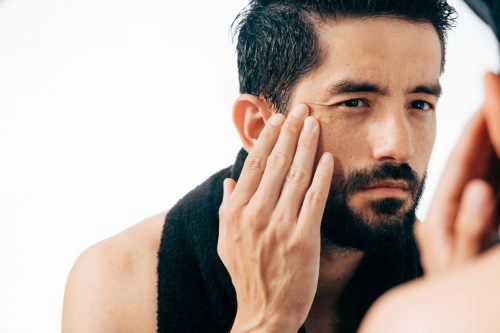
Some people are blessed with the even tone and smooth elasticity that are hallmarks of healthy skin, but is a ‘radiant glow’ achievable through lifestyle habits? Dermatologist Louise Reiche investigates.
Skin damage — the main culprits
We can agree that healthy skin has youthful qualities — it’s elastic, even-toned and radiant. But why do some of us lose these qualities faster than others, ageing prematurely?
There’s no doubt that genetics contribute to both the speed and degree of ageing changes in the skin, but research shows lifestyle and environment also have a part to play.
For instance, studies of twins have revealed smoking and excessive sun exposure over time can cause premature sallowness, deep wrinkling, mottled, irregular pigmentation and scaly skin. There are many pollutants in cigarettes, but carbon monoxide is the main culprit behind skin damage because it deprives cells of necessary oxygen for metabolism, causing premature cell death. By retirement age, someone who has habitually smoked cigarettes can look more than a decade older than a non-smoker.
Exposure to air pollution can add to skin damage.
And then there’s the sun. Long-term exposure to our harsh New Zealand sunlight prematurely ages the skin. Just compare the parts of your skin that are in the sun a lot with the parts usually kept under clothing. It’s likely you’ll see signs of wrinkling, sallowness, and irregular pigmentation.
Finally, poor-quality sleep over prolonged periods is also associated with increased signs of ageing.
Stop the clock
The good news is that there are things you can do to prevent your skin ageing prematurely.
- Avoid smoking for a start. If you need help to quit, call Quitline or talk to your GP.
- Get enough sleep. Regular exercise, a balanced diet, switching off the screen, reading a book and having a hot drink can all help you develop good sleeping habits.
- Take care in the sun. Dermatologists and Cancer Society experts all recommend wearing a hat, high ultra-protective factor (UPF) clothing, sunglasses and high sun protection factor (SPF) broad spectrum sunscreen when out in the sun. This will help prevent skin damage and lower your risk of melanoma.
- Plant-derived chemicals called polyphenols potentially defend us against ultraviolet radiation and attack from pathogens. It is a well-worn truth but eating a balanced diet high in whole fruit and vegetables is the best and safest way to achieve and preserve youthful-looking skin through nutrition, as well as promoting physical and mental health into old age.
Good sources of polyphenols
- black, blue and red fruits
- soy products, such as tofu or soy milk
- vegetables such as onions, potatoes, broccoli, spinach, asparagus and tomatoes
- black and green tea
- cocoa
- coffee
How to be sunsmart and get vitamin D
Most of our vitamin D is produced in the skin through sun exposure, so being sunsmart is a balancing act. We need vitamin D to maintain calcium and phosphorus levels and promote bone health. Studies show people who use sunscreen in summer still have adequate vitamin D levels, and even more if they exercise outdoors. We need only three minutes of sun on our hands, face and neck on an Auckland summer’s day, but 60 minutes on a winter’s day in Invercargill.
If you’re over 50, dark-skinned, immobile, do little outdoor activity or cover up for religious or other reasons, then you may be at risk of deficiency. In this case, see your GP before taking supplements — too much vitamin D can lead to kidney damage and, paradoxically, thin bones.
Oily fish, such as tuna, salmon or mackerel, contains vitamin D, and liver, lamb, eggs, fortified milk and yoghurt have small amounts. But it’s difficult to get enough vitamin D through diet alone.
Skin cancer red flags
Contact your dermatologist or doctor promptly if you notice any of the following on your skin:
- Persistent small, red scaly patches. These may be examples of solar keratosis, which can be precursors to skin cancers. These can also manifest as a painless or tender lump.
- A scab or an ulcer that won’t heal.
- A mole or lesion that has changed shape, size, colour, texture, sensation or feel, or stands out as being different from the rest of your moles (the ‘ugly duckling’ or ‘black sheep’).
Early treatment is more likely to result in a cure, and minimise scarring.
Common skin conditions
Eczema
Eczema is a common skin condition, with various causes, that can make skin appear inflamed, red, itchy or dry, and sometimes blistered or weepy.
Atopic dermatitis, the most common form, is typically seen in people with asthma or hay fever in the family. Eczema usually begins in childhood, frequently arising in skin folds and on the face. Eczema impairs the skin’s barrier function, which is how skin stays hydrated, pliable and resistant to infections and allergies.
Food allergy
Some people with eczema have food allergies, which can be tested for by a health professional.
If an allergy is present, an elimination diet can help decrease eczema’s severity. It’s important for people with food allergies to be regularly reassessed because the allergies can spontaneously resolve. Elimination diets are not effective for treating eczema if you don’t have a food allergy.
Probiotics and supplements
Our skin is covered in helpful microorganisms that protect against disease. Overuse of antibiotics is one of the things that can tip this off balance, but probiotics can help.
Taking probiotics during pregnancy and postnatally potentially decreases the risk of atopic dermatitis in offspring. If there is a strong family history of eczema, exclusive breastfeeding for four months also offers some protection.
Unfortunately, there is no significant scientific evidence that any supplements reduce eczema.
Acne
In contrast to eczema, which is often associated with dry skin, acne is typically associated with oily or greasy skin. Acne usually starts in adolescence when hormones stimulate the skin’s oily sebaceous glands to become more active.
Acne spots or ‘zits’ are known by dermatologists as comedones. Comedones can be treated topically with retinoid products prescribed by a doctor.
Acne and diet
Some foods can help reduce acne while others potentially promote it. Foods that rank high on the glycaemic index, such as white bread and chips, are bad for acne if eaten in large quantities. A high glycaemic load raises blood glucose and stimulates lots of insulin and insulin-related proteins in the blood, aggravating acne (see page 30 for more on low-GI carbs). Numerous studies show a low-GI diet helps improve acne.
Frequently drinking a lot of milk may increase chances of developing or aggravating acne. But fermented milk products such as yoghurt can help mitigate this.
A richly plant-based diet is your best dietary defence, along with drinking plenty of water.
Sleep it off
Make sure you get enough sleep. Adolescents and teenagers need 10—10 1/2 hours’ sleep a night, whereas adults need around eight hours. Regular daily exercise helps improve sleep quality and stimulates production of natural killer cells, an important aspect of skin immunology. Sleep deprivation is also associated with craving higher-GI food, which in turn aggravates acne.
Psoriasis
Psoriasis is a non-contagious skin disease that results in uneven, red and scaly skin. It starts at any age and can run in the family. Occasionally, psoriasis is associated with coeliac disease. In this instance, a diagnosed coeliac’s gluten-free diet can help their psoriasis. Psoriasis is also associated with obesity, cardiovascular disease (CVD) and type 2 diabetes.
Reduced alcohol consumption and weight loss, if needed, can reduce severity and improve the way psoriasis medications work.
Regular vigorous exercise reduces psoriasis risk and helps keep it at bay.
Treatment and risks
If the psoriasis isn’t too widespread, it’s usually treated topically. Widespread and severe psoriasis needs treatment by a dermatologist. In severe cases psoriasis can result in folate deficiency and can increase the risk of CVD.
The diet link
Antioxidants from a diet rich in vegetables, nuts and fruits can be helpful for people with psoriasis, but taking supplements fails to provide the same benefit and may even be harmful. The exception is vitamin D supplementation, which can be helpful if you’re taking acitretin medication, and in those who are deficient. Talk to your GP about it.
Dark-green leafy vegetables are also a great option. They not only provide folic acid but they reduce the toxicity of methotrexate — a powerful medicine for treating stubborn psoriasis.
We have made a guide for the 8 steps to healthy skin, hair and nails and provided some further expert advice on healthy nails and hair repair.
For glowing skin, the magic formula seems to be as it is for health in general: eat plenty of fruit and vegetables, get enough sleep, exercise regularly and drink plenty of water.
Article sources and references
- DermNet NZ. Smoking and its effects on the skin. www.dermnetnz.org Accessed June 2016https://www.dermnetnz.org/
- Du B et al. 2014. Skin health promotion effects of natural beta-glucan derived from cereals and microorganisms: a review. Phytotherapy Research 28:159—66https://www.ncbi.nlm.nih.gov/pubmed/23494974
- Fukushima Y et al. 2015. Skin photoprotection and consumption of coffee and polyphenols in healthy middle-aged Japanese females. International Journal of Dermatology 54:410—8https://www.ncbi.nlm.nih.gov/pubmed/25041334
- Husein-ElAhmed H et al. 2013. Relationship between food intake and cutaneous solar elastosis adjacent to basal cell carcinoma. Journal of the European Academy of Dermatology and Venereology: 27:25—30https://www.ncbi.nlm.nih.gov/pubmed/22112196
- Lew LC & Liong MT. 2013. Bioactives from probiotics for dermal health: functions and benefits. Journal of Applied Microbiology 114:1241—53https://www.ncbi.nlm.nih.gov/pubmed/23311666
- McKenzie R et al. 2014. Effects of measured UV exposure on Vitamin D status of New Zealanders: implications for seasonal exposures required. NIWA UV Workshop. Auckland April 2014https://www.niwa.co.nz/sites/niwa.co.nz/files/McKenzie_UV%20Workshop_2014_UV&VitD.pdf
- Milte CM & McNaughton SA. 2016. Dietary patterns and successful ageing: a systematic review. European Journal of Nutrition 55:423—50https://www.ncbi.nlm.nih.gov/pubmed/26695408
- Mursu J et al. 2011. Dietary supplements and mortality rate in older women: The Iowa Women’s Health Study. Archives of Internal Medicine 171:1625—33https://www.ncbi.nlm.nih.gov/pubmed/21987192
- Murzuku E et al. 2014. Diet in dermatology Part 1. Atopic dermatitis, acne, and nonmelanoma skin cancer. Journal of the American Academy of Dermatology 71:1053.e1—16https://www.ncbi.nlm.nih.gov/pubmed/25454036
- Oyetakin-White P et al. 2015. Does poor sleep quality affect skin ageing? Clinical and Experimental Dermatology 40:17—22https://www.ncbi.nlm.nih.gov/pubmed/25266053
- Palmer ME et al. 2003. Adverse events associated with dietary supplements: an observational study. The Lancet 361:101—6https://www.ncbi.nlm.nih.gov/pubmed/12531576
- Pérez-Jiménez J et al. 2010. Identification of the 100 richest dietary sources of polyphenols: an application of the Phenol-Explorer database. European Journal of Clinical Nutrition 64:S112—20https://www.ncbi.nlm.nih.gov/pubmed/21045839
- Silke K et al. 2012.Discovering the link between nutrition and skin aging. Dermato-Endocrinology 4:298—307https://www.ncbi.nlm.nih.gov/pmc/articles/PMC3583891/
- Vaughn AR & Sivamani RK. 2015. Effects of fermented dairy products on skin: A systematic review. Journal of Alternative and Complementary Medicine 21:380—5https://www.ncbi.nlm.nih.gov/pubmed/26061422
- Yoon HS et al. 2016. Cocoa flavanol supplementation influences skin conditions of photo-aged women: A 24-week double-blind, randomized, controlled trial. The Journal of Nutrition 146:46—50https://www.ncbi.nlm.nih.gov/pubmed/26581682
www.healthyfood.com










